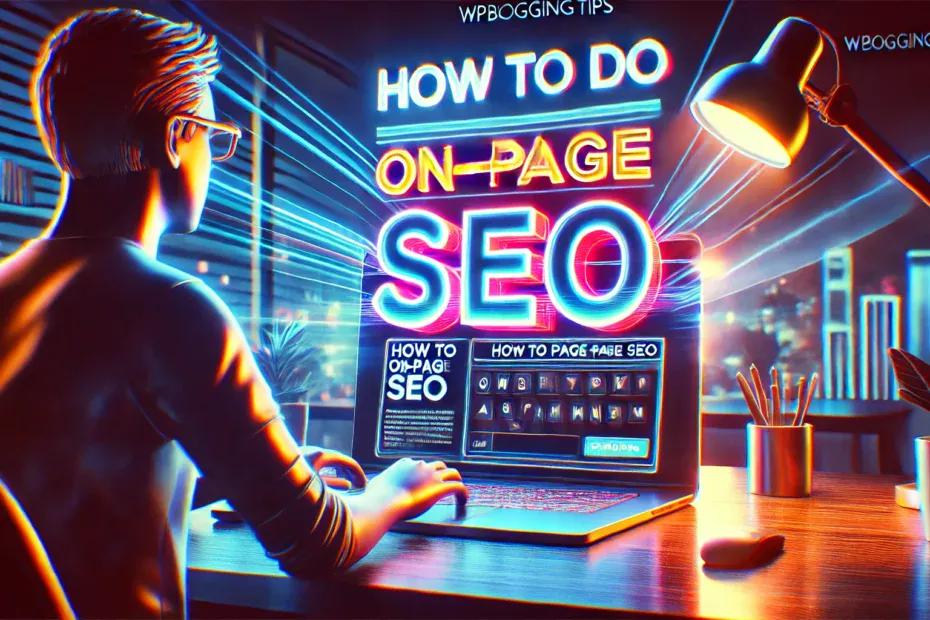On-page SEO is crucial for optimizing your website content to rank higher in search engine results and attract more organic traffic. By focusing on various on-page elements, you can improve your site’s visibility and user experience. This guide will walk you through the essential steps for How to Do On-Page SEO, to perform effective on-page SEO.
What is On-Page SEO?
On-page SEO refers to the practice of optimizing individual web pages to rank higher and earn more relevant traffic in search engines. It involves optimizing both the content and the HTML source code of a page.
Why is On-Page SEO Important?
- Improves Visibility: Helps search engines understand your content and rank it appropriately.
- Enhances User Experience: Ensures your content is readable and engaging for users.
- Boosts Traffic: Higher rankings lead to increased organic traffic.
- Increases Click-Through Rates (CTR): Optimized titles and meta descriptions can improve your CTR.
How to Do On-Page SEO : Key On-Page SEO Elements
1. Title Tags
The title tag is one of the most important on-page SEO elements. It tells search engines and users what your page is about.
- Include Primary Keyword: Place your main keyword at the beginning of the title.
- Keep it Under 60 Characters: Ensure it displays fully in search results.
- Make it Compelling: Write a title that encourages users to click.
2. Meta Descriptions
Meta descriptions provide a summary of your page’s content and can influence CTR.
- Include Primary Keyword: Use your main keyword naturally.
- Keep it Between 150-160 Characters: Ensure it’s concise and fully displayed in search results.
- Make it Engaging: Write a description that entices users to visit your page.
3. Header Tags (H1, H2, H3, etc.)
Header tags help organize your content and make it easier to read.
- H1 Tag: Use a single H1 tag for the main title of the page, including the primary keyword.
- H2, H3 Tags: Use H2 and H3 tags for subheadings to break up content and include secondary keywords.
4. URL Structure
A clean and descriptive URL structure improves both SEO and user experience.
- Include Keywords: Use your main keyword in the URL.
- Keep it Short and Simple: Avoid long and complex URLs.
- Use Hyphens: Separate words with hyphens rather than underscores.
5. Keyword Optimization
Effectively using keywords throughout your content is vital for on-page SEO.
- Primary Keyword: Include it in the first 100 words, title, headers, and conclusion.
- Secondary Keywords: Use related keywords naturally throughout the content.
- Avoid Keyword Stuffing: Do not overuse keywords; maintain natural readability.
6. Content Quality
High-quality content is crucial for SEO and user engagement.
- Provide Value: Ensure your content is informative, useful, and relevant to your audience.
- Use Visuals: Include images, videos, and infographics to enhance the content.
- Length Matters: Longer content (1000+ words) generally performs better in search rankings.
7. Internal Linking
Linking to other relevant pages on your site helps search engines understand your site’s structure and improves user navigation.
- Use Descriptive Anchor Text: Use keywords in the anchor text that describe the linked page.
- Link to Relevant Pages: Ensure the links add value to the reader.
8. External Linking
Linking to authoritative external sites can improve your content’s credibility.
- Use Trusted Sources: Link to reputable and relevant websites.
- Avoid Overlinking: Do not overload your content with too many external links.
9. Image Optimization
Optimizing images can improve page load speed and SEO.
- Use Descriptive File Names: Include keywords in image file names.
- Alt Text: Add descriptive alt text with keywords for each image.
- Compress Images: Reduce file size to improve loading times without compromising quality.
10. Mobile-Friendliness
Ensuring your site is mobile-friendly is crucial as more users access the web via mobile devices.
- Responsive Design: Use a responsive design that adjusts to different screen sizes.
- Mobile Usability: Ensure buttons and links are easy to click on mobile devices.
11. Page Speed
Page load speed is a critical factor for both SEO and user experience.
- Optimize Images: Compress images to reduce load times.
- Use Caching: Implement browser caching to speed up repeat visits.
- Minimize JavaScript and CSS: Reduce the amount of code to improve load times.
Best Practices for On-Page SEO
- Regularly Update Content: Keep your content fresh and relevant.
- Monitor Performance: Use tools like Google Analytics and Search Console to track performance and identify areas for improvement.
- Stay Up-to-Date: Keep up with the latest SEO trends and algorithm updates.
Conclusion
Effective on-page SEO is essential for improving your site’s visibility, user experience, and overall search rankings. By optimizing key elements such as title tags, meta descriptions, headers, and content quality, you can create a strong foundation for your SEO strategy. Start implementing these on-page SEO techniques today to boost your website’s performance.
For more tips on SEO and content optimization, explore our On-Page SEO Optimization Tool and other resources at WP Blogging Tips.

